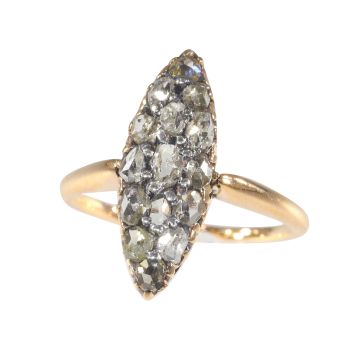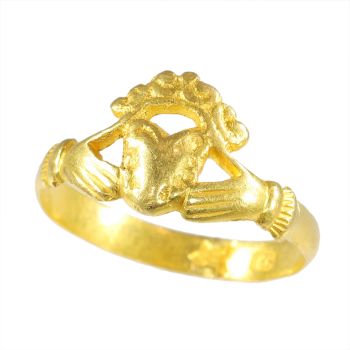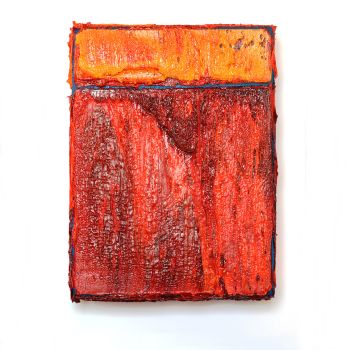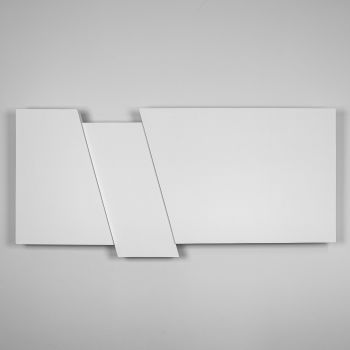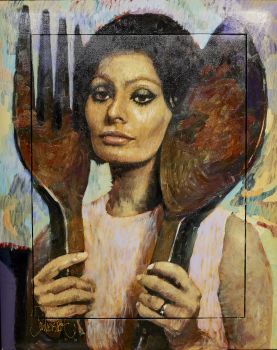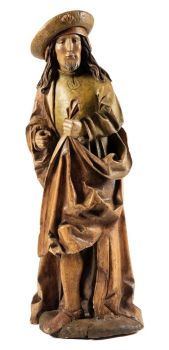A pair of Javanese wooden polychrome painted wall panels, c. 1900 1900
Unknown artist
Wood
71 ⨯ 49 cm
ConditionGood
€ 1.200
Menken Works of Art
- About the artworkAn exquisite pair of carved wooden polychrome relief hand-painted panels in original frames.
Java (Indonesia), late 19th / early 20th century.
The figure on the left panel of the first picture representing Brajadenta. With text at the bottom: 'R.Soeratinin Aro'.
The figure on the right panel of the first picture representing wayang figure Bratasena, the young Bima. With text at the bottom: 'R.(=Raden) Brontoseno. Soerabaja', followed by a date.
A fine example of Javanese folk art
In some parts of Java, wooden plaques like these were placed on the wall around the entrance of the house, to protect the residents from evil spirits.
Dimensions with frames:
Length 71 cm, width 49,5 cm.
Dimensions without frames:
Length 56 cm, width 34,5 cm
Condition:
In a good old condition with some wear - see pictures.
Provenance:
From the collection of Dr. Hedi Hinzler, Leiden, the Netherlands.
Ref:
Soebadio, Haryati - Pusaka Indonesische kunstschatten, p. 173.
Worldwide registered and insured shipping.
Take a look at our other listings for more Asian art, antiques, design, etc.
Inv. No: A00281
-
The story behind the two Wayang figures:
Bratasena:
This puppet represents the character of the Bima also known as Bratasena (Bhima) in the Hindu epic Mahabharata which is performed in the Javanese wayang kulit, or leather shadow puppet theatre tradition. Bima is one of the five Pandava brothers and is recognised by his large thumbnail, that he used to attack his enemies.
Brajadenta:
Brajadenta is the third son of Prabu Arimbaka (Kala Tremboko), the giant king of the Pringgandani state with Dewi Hadimba.
Brajadenta has a stubborn character, wants to win alone, is brave and wants to always follow his heart. He was very powerful, because of that his older brother, Dewi Arimbi, appointed him as the deputy king to hold the reigns of government for the Pringgandani state as long as Dewi Arimbi accompanied her husband Werkudara to live in Jadipati.
At the end of his story, it is told that because he disagreed with the appointment of Gatotkaca, the son of Dewi Arimbi and Werkudara as king of Pringgandani, Brajadenta, assisted by his three younger brothers, Brajamusti, Brajalamatan and Brajawikalpa, rebelled because he wanted to absolutely control the country of Pringgandani.
Gatotkaca crushed his rebellion with the deaths of Brajalamatan and Brajawikalpa. Brajadenta and Brajamusti managed to escape and take refuge in their nephew Prabu Arimbaji, the son of the late Prabu Arimba who had become king in the country of Gowasiluman in the Tunggarana forest. With the help of Bathari Durga, Brajadenta entered Pringgandini's country again to kill Gatotkaca.
His efforts again failed. Brajadenta finally died in the battle against Gatotkaca.
His spirit incarnated into an enchantment / magic and entered / merged into Gatotkaca's teeth. Since then Gatotkaca has supernatural powers; whoever gets bitten by it will surely perish. - About the artist
It might happen that an artist or maker is unknown.
Some works are not to be determined by whom it is made or it is made by (a group of) craftsmen. Examples are statues from the Ancient Time, furniture, mirroirs, or signatures that are not clear or readible but as well some works are not signed at all.
As well you can find the following description:
•“Attributed to ….” In their opinion probably a work by the artist, at least in part
•“Studio of ….” or “Workshop of” In their opinion a work executed in the studio or workshop of the artist, possibly under his supervision
•“Circle of ….” In their opinion a work of the period of the artist showing his influence, closely associated with the artist but not necessarily his pupil
•“Style of ….” or “Follower of ….” In their opinion a work executed in the artist’s style but not necessarily by a pupil; may be contemporary or nearly contemporary
•“Manner of ….” In their opinion a work in the style of the artist but of a later date
•“After ….” In their opinion a copy (of any date) of a work of the artist
•“Signed…”, “Dated….” or “Inscribed” In their opinion the work has been signed/dated/inscribed by the artist. The addition of a question mark indicates an element of doubt
•"With signature ….”, “With date ….”, “With inscription….” or “Bears signature/date/inscription” in their opinion the signature/ date/ inscription has been added by someone other than the artist
Are you interested in buying this artwork?
Artwork details
Related artworks
- 1 - 4 / 12
Unknown artist
A Japanese bronze Hu flower vase, Edo / Meiji, 19th century19th century
Price on requestMenken Works of Art
HUGO VILFRED VON PEDERSEN
Gadesanger fra Singapore (Musician from Singapore)1870 - 1959
Price on requestZebregs & Röell - Fine Art - Antiques
1 - 4 / 16Unknown artist
MATERNITY FIGURE, FANG-MABEA, CAMEROON.PROVENANCE R.CAILLOIS-P.RATTON.1920 - 1930
Price on requestSpectandum Gallery
Unknown artist
Couple Wooden Ancestors Sculptures with Scarifications, Zela People, DRC. 1920 - 1930
Price on requestSpectandum Gallery
1 - 3 / 3Theo Meier
“A Balinese woman with offerings”1936
Price on requestZebregs & Röell - Fine Art - Antiques
1 - 4 / 12Unknown artist
UITGEBREIDE FEESTDAGENIKOON MET PASSIECYCLUS19th century
Price on requestHeutink Ikonen
1 - 4 / 24Unknown artist
Chinese gilt bronze censer, Xuande mark, 18th century, Qing dynasty18th century
Price on requestMenken Works of Art
Unknown artist
A white jade ‘Lotus Seedpod and Bug’ carving, Qing dynasty, 18th century18th century
Price on requestMenken Works of Art
1 - 4 / 12









